Imagine a world where you had a digital personal assistant that you could access with voice commands from wherever you are through any internet-connected device, and it would handle all of your online interactions for you as you move about from home to the car to work and beyond.
This world is becoming a reality, and it’s not just useful for consumers—brands have a real opportunity to be early adopters. So how can your brand get in on the action? That’s what I’m going to talk about today.
For reference background, read my April 2017 post that rates the smarts of digital personal assistants.
The Rise of Digital Personal Assistants
Before we can understand how digital personal assistants work, let’s talk about some of the factors that are causing digital personal assistants to become so important today, and even more so as we get into the next couple of years.
Dramatic Growth of Voice Search
First, there’s the fact that voice search is growing dramatically in its prominence. And it’s this technology that’s the backdrop for digital assistants. Here are a few interesting stats from KPCB’s 2016 Internet Trends Report presented by Mary Meeker.
[Tweet “The rapid growth of voice search is driving the rush to create digital personal assistants. More at”]
Of particular interest is a statement from Andrew Ng of Baidu forecasting that 50 percent of all searches performed in the year 2020 will either be through images or speech.
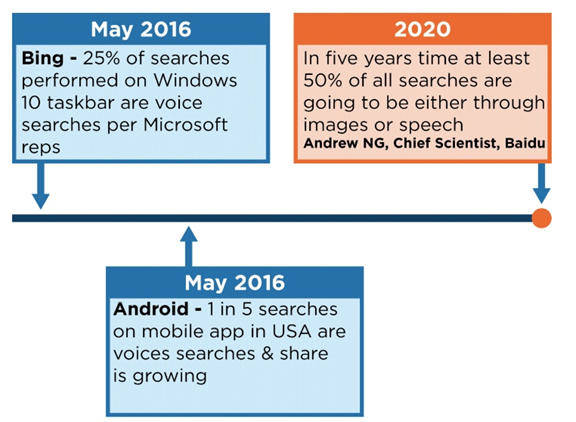
That’s a fascinating data point when you think about it. If that comes to fruition, we’re talking less than three years in the future—a pretty drastic shift.
One of the things that’s making this shift a reality is the rise of smartphone devices and their prominence. Because it’s still awkward to type on a smartphone keyboard, and because people are interacting with devices on the go, it’s convenient to say, “Hey Siri” or “OK Google” and just talk to a device instead.
This is already driving some significant changes in the penetration of voice search.
In fact, we conducted a survey here at Perficient Digital of more than 900 U.S. smartphone users to find out where people are using voice search most. As many as two-thirds of people in the survey are already comfortable using voice commands with their phones at home.
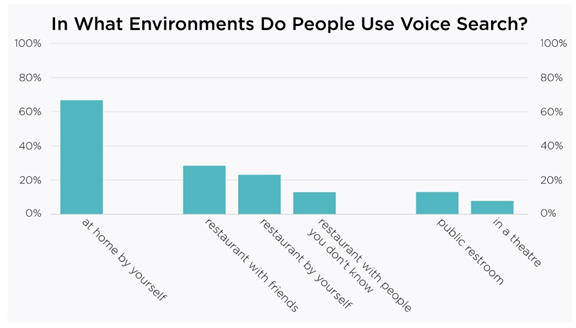
So, that means a very large percentage of the population is already engaging with voice search. That’s one of the big drivers of why digital personal assistants are going to be so important.
Did you know that you can “Ask Perficient Digital” SEO & digital marketing questions on Google Assistant and Amazon Alexa devices? Here’s how to do it!
Rise of Internet-Connected Devices
The other major trend that’s happening is the fantastic rise of new types of devices that are internet connected, and that’s where we get into the Internet of Things (IoT).
Data from Strategy Analytics in 2014 forecast that by the year 2020, 75 percent of internet-installed devices will be something other than a PC, tablet or a smartphone.
[Tweet “What’s behind the growth of digital personal assistants? One thing is the rise of the Internet of Things.”]
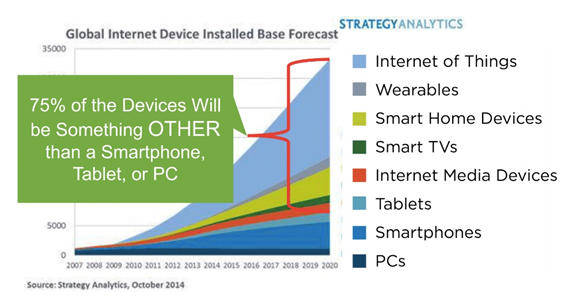
So, all the devices that we think of as being internet connected today will be a small minority of the total number of internet-connected devices. Think about that for a second: An Internet-enabled TV, a thermostat, a refrigerator, your car. These are places where you’re not typing something, so as they get more sophisticated, your primary interaction will be voice-based.
This becomes a really important concept because it leads to a world in which interactions won’t happen through a browser. You won’t conduct your search, for the most part, through search boxes in a browser window. You’ll be using voice commands to talk to your personal assistant and get answers.
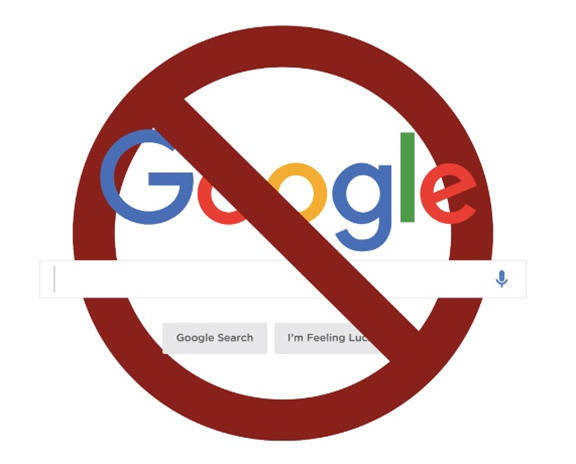
In this world, you can seamlessly move about and your assistant will be wherever you are, from your home to your car, and it will be able to pick up the conversation where it left off previously.
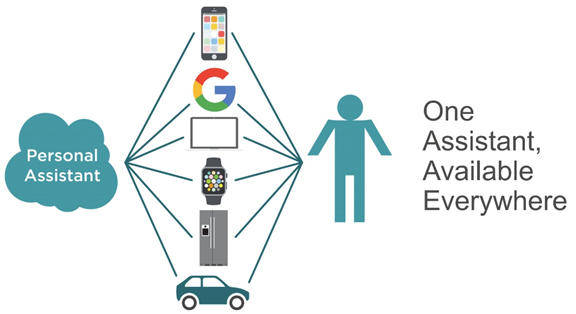
For example, you might have left your phone in your office when you went to lunch, but you still want to check your flight schedules for later in the week. So, you just say, “OK Google” and you’re personal assistant wakes up through your car connection to the internet, and allows you to check your schedule.
You might then get your lunch, go back to the office and realize you haven’t actually set up a hotel at the destination city. You say, “OK Google” again, but this time, it’s your phone that responds.
You then tell the assistant that you need a hotel after you land in San Francisco and it remembers the context from the conversation you started in the car, and helps you book a room. As part of this, it remembers your room preferences, and makes sure to get you a non-smoking room and a king bed.
When you go for a walk later, you realize you want to book a dinner the night that you arrive in San Francisco. So you say, “OK Google” again, and this time, it wakes up through your smartwatch and allows you to book the restaurant of your choice. It knows that you like to eat at the Stinking Rose, so it suggests that to you, and when you say yes, it handles the rest.
This is the concept of the digital personal assistant—connectivity through any internet-connected device. Ideally, this personal assistant will be able to handle a tremendous amount of stuff for users online—without the user ever having to type in a query into a search bar.
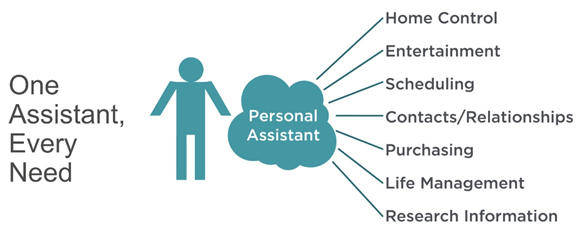
Now, this only works if the various personal assistant providers have established connectivity through a lot of different hardware devices, and also have wired into a large array of different services and apps.
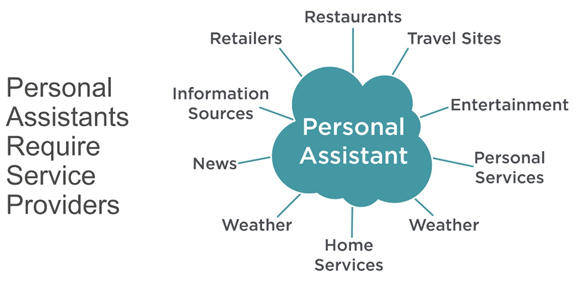
This is where the market is going, and this is the reason why companies such as Apple, Microsoft, Amazon and Google all are investing heavily in personal assistant technology.
This is also why there is a great deal of opportunity in the arena of creating personal assistant apps, and smart site publishers are jumping on board early to tap into this burgeoning market.
Smart Speakers That Host Personal Digital Assistants
Part of the IoT space that may not be as familiar to some yet is the category of smart speakers. Smart speakers are standalone devices that you leave at home or in the office or anywhere that you want to interact with your personal assistant.
Examples of smart speakers include the Amazon Echo device, which has a software application in it that uses a personal assistant called Alexa. Then, there’s the Google Home device, which has the Google Assistant running on it.
Smart speakers haven’t been around that long, but the forecasts say that there will be more than 100 million of these smart speakers installed in the United States by 2024, or roughly 30 percent of the population, which is an amazing rate of penetration for such a new category of device.
To put that in context, look at the rate of adoption of technology over history in our civilization. The telephone took 110 years to reach a billion users. The television did it in a lot less time—only 49 years.
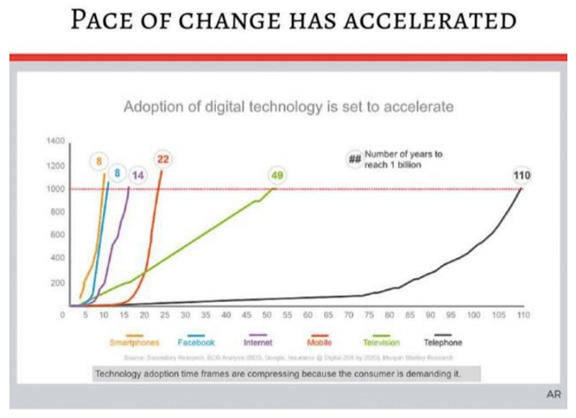
Things like smartphones and Facebook took eight years. It does not look like smart speakers by themselves will grow to 1 billion devices in 8 years, but they’re clearly growing very fast.
But, they do feed into the adoption rate of digital personal assistants, and I do believe that the category of digital personal assistants could grow to a billion in eight years. That is a pretty dramatic shift in the landscape.
It’s for all these reasons that I believe this is an extremely important category for digital marketers to pay attention to.
Apps for Digital Personal Assistants
Building an app for one of these assistants can provide great value to your target audience, and provide strong exposure for your brand.
[Tweet “Building apps for digital personal assistants could give your brand an early adopter advantage. More>”]
With the IoT comes the opportunity for brands to create applications that run on personal assistants. To create an application for Amazon’s Echo device and the Alexa personal assistant, you would pursue what’s called Alexa Skills.
For the Google Assistant (including the Google Home device), you would develop what’s called Actions on Google.
As a third-party developer, your brand can build your own “skills” or “actions” and plug into the Google Home and Amazon Echo ecosystems.
As a brand, you have an opportunity to be a pretty early adopter in a space that looks like it’s going to be extremely strong and important for marketers. Here are some reasons to consider jumping in early:
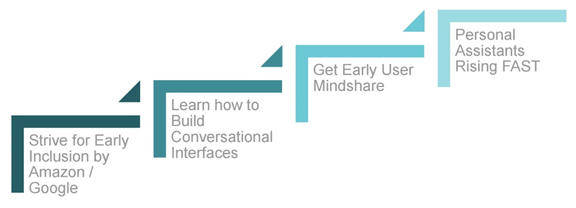
At Perficient Digital, we built an Actions on Google app (aka a Google Assistant app) that allows a person to ask SEO questions, including how to do certain kinds of SEO tasks, and incorporates an SEO quiz where a user can test their knowledge.
So next, I want to talk about building one of these things, and I’m going to focus initially on building Actions on Google.
How Google Assistant Answers Queries: The Technical Details
The Google Assistant will use purpose-built apps if they’re available to answer a user’s query, and as a backup, use the web (pulling from featured snippet results).
The following chart is one that we’ve developed here at Perficient Digital to show how the Google Assistant answers queries.
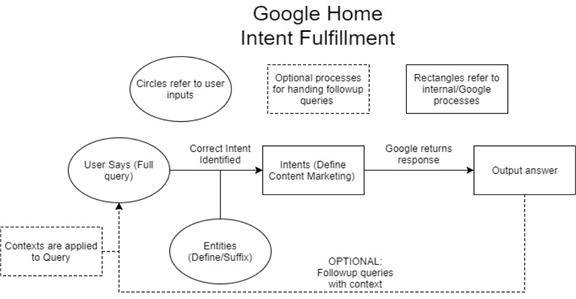
The chart above shows a basic flow of how things work when a user interacts with a personal assistant. For reference, the top row is simply the definition of the objects in the chart, and the bottom two rows show the actual flow.
If we start at the left, this is where the user speaks their query. Next, the intent is identified by Google, then Google returns a response.
Let’s say I want to ask Google Home: “What is content marketing?” There’s a process of parsing the query that involves identifying that the key phrase is “content marketing.” The words preceding that—the “what is”—are the prefix to the core part of the query, and that can take many forms.
In this example, I said “What is content marketing?” but I could have also said: “Tell me what content marketing is.” There are many different ways that users could ask the query, but in each case what they really want to know is what content marketing is.
So there’s an entire parsing process that you have to set up manually for Google Home. Our two input circles in the chart relate to that, and we’ll talk about that next.
An Overview of How to Set Up Actions on Google
To set up Actions on Google, you work with api.diagflow.com. Next, I’ll show you some views of what that interface looks like to give you some idea of what it’s like to work with it. (At any time, you can learn more about how to fulfill a user request in this help file here.)
First, you have to define or create a list of intent. In the following screenshot, you see “Default Fallback Intent,” “Default Welcome Intent,” “Define: 301 Status Code,” “Define: 302 Status Code,” “Define: 400 Status Code.” These are all definitions in the app that we built that users can ask about.

In Diagflow.com, you can build a list of core terms. Then, in response to each of those, you build out an answer, as you can see in the following image where it says “Text Response.” This is showing an answer to the question, “What is content marketing?”

Up top, you can see where it says “define content marketing.” Content marketing is the “intent” and “define” is the term we use to say what we are doing with this intent.
In this case, the prefix, or what we’re calling the “define,” might be “what is,” and then the “intent” is “content marketing.” Together, that tells Google Home what to do and to output the text response.
Look at the three checkboxes in the middle. Because of the blue checked box, the first one says that a user can’t just say “content marketing,” but needs to have some sort of prefix to it that tells Actions on Google what to do with it.
You’ll notice the box for the suffix is not checked. That means users can ask the query: “What is content marketing?” and our app on Google Home will process that. In other words, no suffix is required.
To give you some idea of what some of the possible “defines” are, you also have to build out the following table. This table is where you tell Google what all the possible prefixes are.

Keep in mind, in our example, “content marketing” is the core term we’re using. The user could say: “Define content marketing.” They could say, “What is content marketing?” They could say, “What does content marketing do?” All these things are examples of ways that users could ask the question. So, you literally have to build out all those examples so that the Google Assistant knows that they are all valid input questions.
The next image shows some specific definitions for one intent. What you’re seeing is in the first row where it says “define content marketing suffix” highlighted in orange, is the core query structure.
Then below it are a couple of examples. What does content marketing mean? This sort of language analysis is core to everything before you get off the ground.
And then we have another place where we specify the execute phase; this is where we marry the types of queries users might ask with the actual output from the device.

This is just a sampling of the extensive work you have to do just for a very simple app like the kind that we built at Perficient Digital.
Once you’ve built your app, you need to test it. To do that, you connect to your Google Home device in Diagflow.com in what they call “test mode.” This means it’s not available to the world yet, but simply running locally for you. You can debug your app quite easily with this. You can learn more about testing the app here.
Once you’re happy with the results, you’ll need to submit your app to Google for certification or inclusion, so that other people can download it.
This is a process that I believe digital marketers should be beginning to learn now because this form of users interacting online is going to be a very significant factor in the digital marketing landscape within two years.
That means, there is a very large opportunity to jump on board with these types of apps now. The risk is that if you wait too long, you’ll get behind you’re competition, and frankly, I’m not a fan of that!


Useful Information. Growth of Digital Personal Assistant is increasing day by and day.It’s the era of Internet that’s why Digital Personal Assistant demand is higher. This demand would gradually increase with the passage of time.
it’s very scary for me this digital assistant.
they have many data from us and it’s very dangerous for our personal privacy.
Really informative article and I totally agree with you that everybody needs the personal assistant because Google is getting smart day by day and We need to understand it, so we can easily get ranked in Google SERP. I liked the resources that you have shared with us. Thank you.
A personal digital assistant can be deftly connected to a computer, which is great for busy people.
Impressive!! you have defined how Google assistant works on this amazing tutorial. This step by step guide shows us how important Google assistant work to get us results. I totally agree we need to create the intent to get the information regarding what user needs.
I can’t thank you enough for trying this out, and bringing your discoveries to readers like me. I am emboldened! But, it just occurred to me that the visually-challenged among us would so greatly benefit from smoother, intent-driven voice interfaces, than the passive reader technology so prevalent, now. A win for a wider world!
it’s very scary for me this digital assistant.
Why is that?